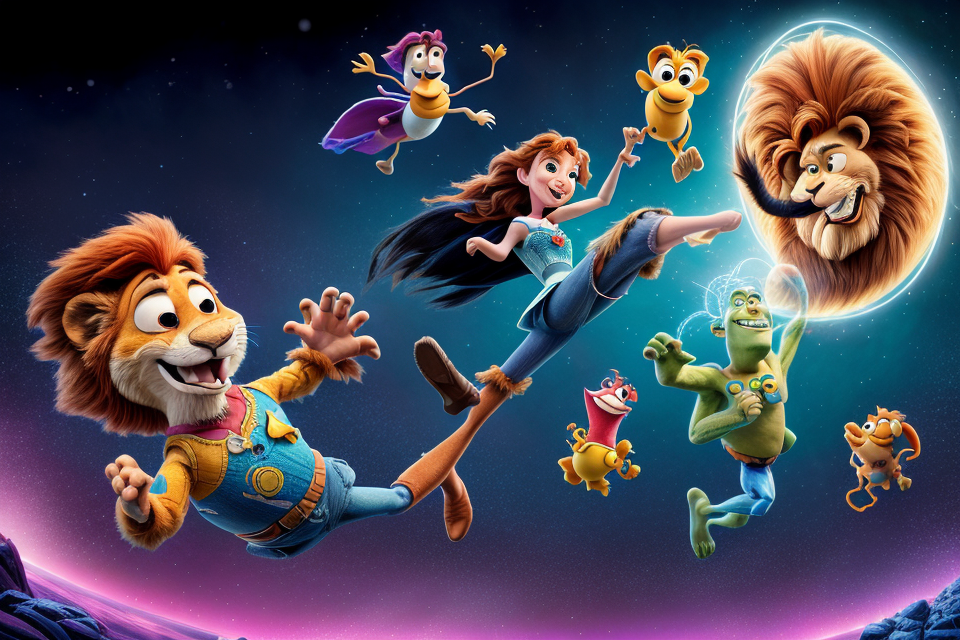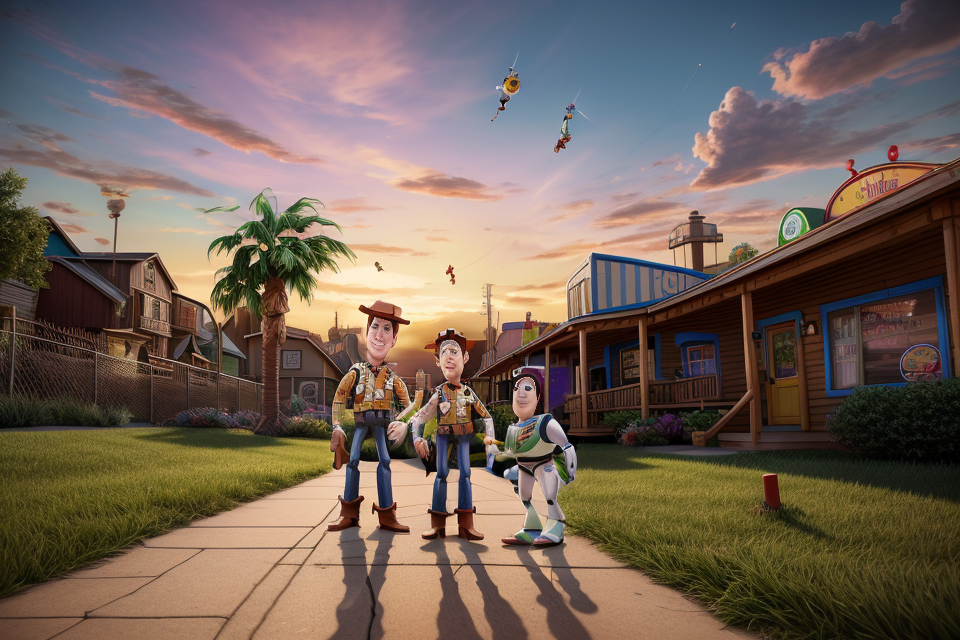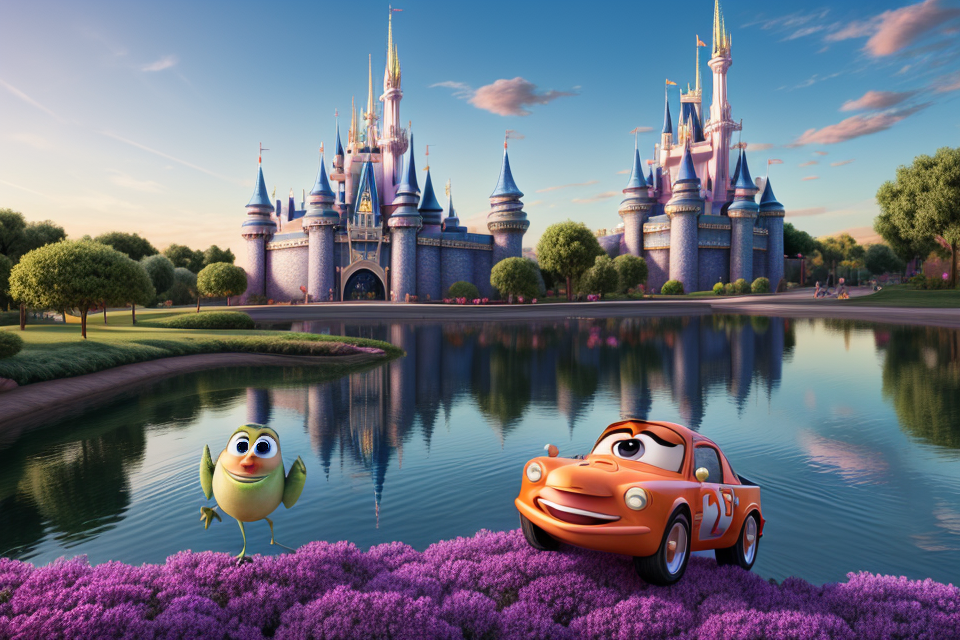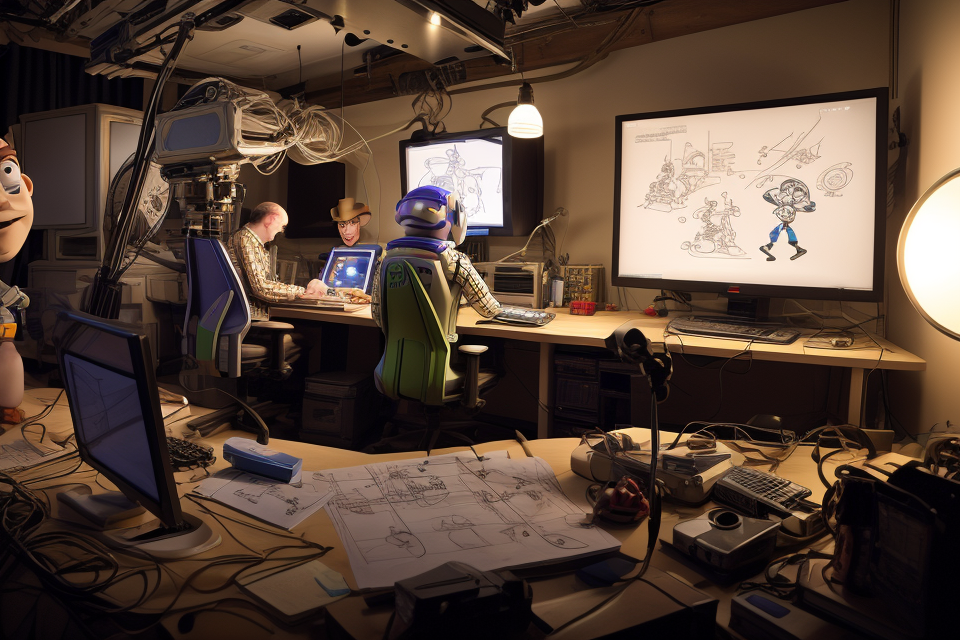
Pixar, the animation studio behind beloved movies such as Toy Story, Finding Nemo, and The Incredibles, is often associated with Disney. But what exactly does Pixar mean in Disney’s world of animation? This article aims to explore the relationship between Pixar and Disney, and shed light on the role that Pixar plays in Disney’s animated film universe. Get ready to dive into the fascinating world of animation and discover how these two powerhouses of the entertainment industry come together to create magical movies that capture our hearts and imaginations.
The Origins of Pixar
The Early Years
Pixar Animation Studios was founded in 1979 by a group of computer scientists and artists who set out to create high-quality computer-animated films. Among the co-founders were Ed Catmull, who later became the president of both Pixar and Disney Animation, and Steve Jobs, who would later become the CEO of Apple. The company was initially called the Graphics Group, and it was part of Lucasfilm’s computer division.
The early years of Pixar were marked by a number of challenges and setbacks. One of the biggest challenges was the technology itself, which was still in its infancy. The company had to develop its own software and hardware to create computer-animated films, which was a complex and time-consuming process. Additionally, the company struggled to find investors and secure funding for its projects.
Despite these challenges, Pixar continued to innovate and push the boundaries of computer animation. The company’s first feature film, “Toy Story,” was released in 1995 and was a critical and commercial success. It was the first fully computer-animated feature film and set a new standard for the industry. The film’s success helped to establish Pixar as a major player in the animation industry and paved the way for future films like “Monsters, Inc.,” “Finding Nemo,” and “The Incredibles.”
Overall, the early years of Pixar were marked by a combination of technical challenges, financial struggles, and creative innovation. Despite these challenges, the company’s founders remained committed to their vision of creating high-quality computer-animated films and continued to push the boundaries of what was possible in the field.
The Pixar-Disney Merger
In 1986, Steve Jobs, co-founder of Apple Inc., purchased the computer graphics division of Lucasfilm, which was renamed Pixar Animation Studios. Over the next two decades, Pixar would become a pioneer in computer-animated feature films, producing a string of critically acclaimed and commercially successful movies, including “Toy Story” (1995), “A Bug’s Life” (1998), “Toy Story 2” (1999), “Monsters, Inc.” (2001), and “Finding Nemo” (2003).
Despite this success, Pixar’s relationship with Disney was initially strained. Disney had initially declined to distribute “Toy Story,” Pixar’s first feature film, which went on to become a massive hit. However, in 2006, Disney purchased Pixar in a landmark deal worth $7.4 billion, making Pixar a subsidiary of Disney.
The merger brought together two of the most successful and innovative animation studios in the world, creating a new era of collaboration and creativity. The deal gave Disney access to Pixar’s cutting-edge technology and animation expertise, while Pixar gained access to Disney’s vast resources and distribution network.
Since the merger, Pixar has continued to produce critically acclaimed films, including “The Incredibles” (2004), “Ratatouille” (2007), “Up” (2009), “Toy Story 3” (2010), “Brave” (2012), “Inside Out” (2015), “Coco” (2017), and “Incredibles 2” (2018). These films have not only been critical successes but also commercial ones, with “Toy Story 3” and “Incredibles 2” both grossing over $1 billion at the global box office.
The merger also allowed Pixar to expand its storytelling horizons, incorporating new characters and storylines into the larger Disney animated universe. For example, “Toy Story” characters Woody and Buzz Lightyear have appeared in Disney’s “Toy Story Land” theme park attractions, while Pixar’s “Inside Out” character Joy has made appearances in Disney’s “Mickey’s Magical Express” attraction.
Overall, the Pixar-Disney merger has been a win-win for both companies, leading to a new era of collaboration and creativity in the world of animation.
Pixar’s Impact on Disney Animation
The Integration of Pixar’s Technological Advances
When Disney acquired Pixar in 2006, it marked a turning point in the animation industry. Pixar had been a leader in computer-generated animation, with its groundbreaking technology and visually stunning films. The integration of Pixar’s technological advances into Disney’s animation process has been transformative, leading to a new era of innovation and creativity.
One of the key technological advances that Pixar brought to Disney was its proprietary animation software, known as “Presto.” This software allowed animators to create more realistic movements and expressions, as well as greater control over lighting and shading. With Presto, Disney animators were able to bring their characters to life in ways that were previously impossible.
In addition to software, Pixar also brought with it a culture of innovation and experimentation. Pixar’s artists and technicians were encouraged to push the boundaries of what was possible, resulting in a steady stream of technological advances. This culture of innovation has spread throughout Disney’s animation studios, leading to a new era of creativity and experimentation.
The integration of Pixar’s technology has also had a profound impact on the way that Disney approaches storytelling. With the ability to create more realistic movements and expressions, Disney’s animators are able to convey a greater range of emotions and ideas. This has led to more complex and nuanced stories, as well as more visually stunning films.
Overall, the integration of Pixar’s technological advances has been transformative for Disney’s animation process. With access to cutting-edge technology and a culture of innovation, Disney is able to create films that are both visually stunning and emotionally engaging.
The Infusion of Pixar’s Creative Approach
The acquisition of Pixar by Disney in 2006 marked a turning point in the animation industry. Pixar, known for its groundbreaking computer-animated films, brought a fresh and innovative approach to Disney’s traditional animation techniques. This fusion of creative styles has resulted in a new era of animation that has redefined the possibilities of storytelling.
Embracing Computer-Animation Technology
Pixar’s use of computer-animation technology has revolutionized the animation industry. With the ability to create lifelike movements and expressive characters, Pixar’s films have captured the hearts of audiences worldwide. The integration of this technology into Disney’s animation process has allowed for more dynamic and realistic movements, opening up new possibilities for storytelling.
Pixar’s Storytelling Approach
Pixar’s approach to storytelling has also had a significant impact on Disney’s animated films. Pixar’s focus on character development and emotional depth has added a new dimension to Disney’s traditional storytelling techniques. This has led to more complex and relatable characters, resulting in a deeper emotional connection with audiences.
Collaboration and Cross-Pollination of Ideas
The collaboration between Pixar and Disney has also led to cross-pollination of ideas, with both studios drawing inspiration from each other’s strengths. Pixar’s unique approach to storytelling has influenced Disney’s live-action films, while Disney’s traditional animation techniques have been incorporated into Pixar’s films. This exchange of ideas has resulted in a more diverse and dynamic range of films, showcasing the best of both worlds.
In conclusion, the infusion of Pixar’s creative approach into Disney’s animated film universe has had a profound impact on the animation industry. The fusion of computer-animation technology, storytelling techniques, and collaboration has resulted in a new era of animation that continues to push the boundaries of what is possible.
Pixar’s Contributions to Disney’s Animated Film Universe
The Development of Original Stories
Since its acquisition by Disney in 2006, Pixar has played a significant role in the development of original stories for Disney’s animated film universe. The company, known for its critically acclaimed and commercially successful computer-animated feature films, has brought a fresh perspective and innovative approach to Disney’s storytelling.
Pixar’s influence can be seen in the production of films such as Tangled, Wreck-It Ralph, and Frozen, which have all incorporated elements of Pixar’s unique storytelling style. This includes a focus on character-driven narratives, witty dialogue, and emotional depth, as well as an emphasis on humor and action.
In addition to bringing new stories to the table, Pixar has also helped to push the boundaries of animation technology. Its use of advanced computer-generated imagery (CGI) has allowed Disney to create more visually stunning and realistic animated films, further enhancing the company’s reputation as a leader in the animation industry.
Overall, Pixar’s contributions to Disney’s animated film universe have been substantial and far-reaching, and the company’s influence can be seen in many of the most successful and beloved animated films of the past decade.
The Introduction of New Characters
Since Pixar’s acquisition by Disney in 2006, the two animation studios have collaborated to create a vast and diverse animated film universe. One of the most significant contributions of Pixar to Disney’s animated film universe is the introduction of new and unique characters. These characters not only add to the richness of the animated film universe but also help to expand the narrative possibilities and appeal to wider audiences.
One of the most iconic examples of this is the character of Woody from the Toy Story franchise. Woody, a pullstring cowboy toy, was introduced in the first Toy Story film in 1995, and has since become a beloved character in the Disney animated film universe. Woody’s story, along with that of his fellow toy friends, has continued to evolve and expand in subsequent films, with each film adding new layers to the characters and their relationships.
Another example is the character of Dory from the Finding Nemo franchise. Dory, a forgetful blue fish, was introduced in the first Finding Nemo film in 2003, and has since become a fan favorite. Dory’s story has continued to unfold in the sequel film Finding Dory, which was released in 2016. This film provided a deeper understanding of Dory’s background and her struggle with her short-term memory loss, adding depth and complexity to her character.
These are just a few examples of the many new characters that Pixar has introduced to Disney’s animated film universe. By creating unique and relatable characters, Pixar has helped to enrich the animated film universe and make it more appealing to audiences of all ages.
Pixar’s Influence on Disney’s Animated Film Universe
The Evolution of Disney’s Animation Style
Pixar’s influence on Disney’s animated film universe can be seen in the evolution of Disney’s animation style. Disney, known for its traditional hand-drawn animation, has evolved over the years to incorporate computer-generated imagery (CGI) and other technological advancements in its films.
One of the most significant changes in Disney’s animation style can be seen in the film “Beauty and the Beast” (1991), which was the first animated film to use computer-generated imagery in its production. The film’s iconic ballroom dance sequence, which features a detailed and intricate background, was created using CGI.
With the release of “Toy Story” (1995), Disney’s collaboration with Pixar marked a new era in animation. Pixar’s groundbreaking use of computer-generated imagery in its films, combined with Disney’s timeless storytelling, resulted in a new style of animation that blended the traditional hand-drawn animation with CGI.
The integration of Pixar’s technology and animation style can be seen in later Disney films such as “The Lion King” (1994), “Aladdin” (1992), and “The Little Mermaid” (1989), which all incorporated CGI elements into their animation.
The evolution of Disney’s animation style can also be seen in its use of motion capture technology, which allows animators to capture the movements of actors and incorporate them into the animation. This technique was used in films such as “Avatar” (2009) and “The Jungle Book” (2016), which featured realistic animal movements and expressions.
Overall, Pixar’s influence on Disney’s animated film universe can be seen in the evolution of Disney’s animation style, which has incorporated technological advancements such as CGI and motion capture technology to create a new style of animation that blends traditional hand-drawn animation with modern technology.
The Expansion of Disney’s Animated Film Universe
Introduction to Disney’s Animated Film Universe
Prior to the acquisition of Pixar in 2006, Disney’s animated film universe consisted primarily of traditional 2D animation, with films such as Snow White and the Seven Dwarfs (1937) and The Lion King (1994) being some of the most notable examples.
The Integration of Pixar’s CGI Technology
Following the acquisition of Pixar, Disney began to integrate the latter’s cutting-edge CGI technology into their animated films. This integration has allowed Disney to create more visually stunning and technically advanced films, such as Frozen (2013) and Moana (2016).
The Expansion of the Animated Film Universe
The integration of Pixar’s technology has also allowed Disney to expand their animated film universe beyond traditional 2D animation. This expansion has led to the creation of new and innovative worlds, such as the futuristic city of Zurg in Toy Story (1995), and the underwater kingdom of Atlantis in The Little Mermaid (1989).
The Impact of Pixar’s Influence on Disney’s Animated Film Universe
The integration of Pixar’s technology and the expansion of Disney’s animated film universe have had a profound impact on the animation industry as a whole. By pushing the boundaries of what is possible with CGI technology, Disney has set a new standard for animated films, inspiring other studios to follow suit and invest in their own CGI technology.
Conclusion
In conclusion, the acquisition of Pixar has allowed Disney to expand their animated film universe beyond traditional 2D animation, leading to the creation of more visually stunning and technically advanced films. The integration of Pixar’s technology has also inspired other animation studios to invest in their own CGI technology, pushing the boundaries of what is possible in the animation industry.
The Future of Pixar in Disney’s Animated Film Universe
Upcoming Pixar-Disney Collaborations
As the world of animation continues to evolve, it is worth exploring the future of Pixar in Disney’s animated film universe. The two studios have already collaborated on numerous successful projects, but what does the future hold?
Sequels and Prequels
One of the most exciting aspects of the future of Pixar in Disney’s animated film universe is the promise of new sequels and prequels. Fans of the Toy Story franchise, for example, can look forward to the release of Toy Story 4 in 2022. The Incredibles 2, which was released in 2018, also left the door open for a potential sequel, and rumors suggest that one is in the works.
In addition to sequels, there are also plans for prequels to some of Pixar’s most beloved films. The upcoming film Soul, for example, is a prequel to the 2008 film The Incredibles. It follows the story of Joe Gardner, a middle school music teacher who dreams of being a jazz musician. The film is set to be released in June 2022.
New Properties
While sequels and prequels are certainly exciting, the future of Pixar in Disney’s animated film universe also promises new properties that are sure to captivate audiences. One such property is Luca, which is set to be released in 2021. The film is a coming-of-age story about a young boy named Luca who dreams of becoming a sea monster.
Another promising new property is Turning Red, which is set to be released in 2022. The film follows the story of a young girl named Mei who struggles with her family’s traditional expectations and her own desire to break free and explore the world.
Expanding the Universe
In addition to new properties, the future of Pixar in Disney’s animated film universe also promises an expansion of the existing universe. This includes the integration of characters from different franchises, as well as the exploration of new worlds and settings.
One example of this is the upcoming film, The Incredibles 3, which is rumored to feature a crossover with the Monsters, Inc. franchise. This would allow for the integration of beloved characters from both franchises, creating a richer and more diverse universe.
Overall, the future of Pixar in Disney’s animated film universe is filled with exciting possibilities. From sequels and prequels to new properties and an expanding universe, there is much to look forward to in the years to come.
The Potential for Further Integration
- Exploring the Possibility of More Crossover Films
- The Popularity of Crossover Films
- The Success of Films Like “Toy Story” and “The Incredibles”
- The Growing Demand for Crossover Films
- The Potential for New Crossover Films
- The Introduction of New Characters and Worlds
- The Opportunity to Expand the Disney Animated Film Universe
- The Popularity of Crossover Films
- The Potential for Increased Collaboration
- The Benefits of Collaboration
- The Sharing of Resources and Expertise
- The Ability to Explore New Creative Possibilities
- The Potential for Joint Production
- The Opportunity to Create Bigger and More Ambitious Films
- The Chance to Combine the Strengths of Both Studios
- The Benefits of Collaboration
- The Possibility of Further Acquisitions
- The Potential for Pixar to Acquire Additional Animation Studios
- The Benefits of Acquiring Additional Talent and Resources
- The Opportunity to Expand the Disney Animated Film Universe Even Further
- The Potential for Pixar to Merge with Disney Animation
- The Chance to Create a Unified Animated Film Studio
- The Opportunity to Streamline Operations and Increase Efficiency
- The Potential for Pixar to Acquire Additional Animation Studios
- The Impact of Technological Advancements
- The Potential for New Technologies to Enhance the Quality of Animated Films
- The Use of Virtual Reality and Augmented Reality
- The Introduction of New Software and Tools
- The Potential for Pixar to Continue Pushing the Boundaries of Animation
- The Opportunity to Experiment with New Techniques and Formats
- The Chance to Create More Innovative and Groundbreaking Films
- The Potential for New Technologies to Enhance the Quality of Animated Films
The Impact of Pixar on Disney’s Animated Film Universe
The Increased Competition in the Animated Film Industry
Pixar’s entry into the animated film industry in 1995 marked a turning point, not only for Disney but also for the entire industry. With the success of “Toy Story,” Pixar established itself as a major player in the world of animation, and its films consistently outperformed Disney’s in terms of critical acclaim and box office revenue.
The introduction of Pixar to the industry also increased competition among animation studios. Prior to Pixar’s arrival, Disney had enjoyed a virtual monopoly on theatrical animation, with only a few small studios attempting to compete. However, with the success of Pixar’s films, other studios began to enter the market, such as DreamWorks, Blue Sky Studios, and Illumination Entertainment.
The increased competition in the industry led to a rise in the quality of animation and storytelling, as studios sought to emulate Pixar’s success. It also forced Disney to adapt and evolve in order to remain relevant in the changing landscape of animation.
The Advancement of Animation Technology
The integration of Pixar into Disney’s animated film universe has had a profound impact on the advancement of animation technology. The following are some of the key ways in which Pixar has contributed to this advancement:
Improved Computer Animation Software
One of the most significant contributions of Pixar to the animation industry has been the development of advanced computer animation software. Pixar’s proprietary software, known as “Pixar Animation Studio Software,” has enabled animators to create more realistic and nuanced movements and expressions in their characters. This software has also allowed for greater control over the rendering process, resulting in more detailed and visually appealing animation.
Enhanced Visual Effects
Pixar’s expertise in computer animation has also led to significant advancements in visual effects. Pixar’s artists have developed techniques for creating seamless blends between live-action footage and computer-generated imagery, allowing for more realistic and immersive storytelling. Additionally, Pixar’s software has enabled the creation of complex particle effects, such as fire, smoke, and water, which can be used to enhance the realism of a scene.
Greater Artistic Freedom
Another way in which Pixar has advanced animation technology is by providing animators with greater artistic freedom. With the use of computer animation software, animators can create more intricate and detailed character designs, as well as more expressive and nuanced movements. This increased artistic freedom has allowed animators to push the boundaries of what is possible in animation, resulting in more innovative and creative storytelling.
Improved Rendering Process
Finally, Pixar’s expertise in computer animation has also led to significant advancements in the rendering process. Pixar’s software allows for more detailed and complex lighting and shading effects, resulting in more visually appealing and realistic animation. Additionally, Pixar’s rendering process is more efficient than traditional animation methods, allowing for faster production times and lower costs.
Overall, the integration of Pixar into Disney’s animated film universe has had a significant impact on the advancement of animation technology. Pixar’s contributions to computer animation software, visual effects, artistic freedom, and rendering process have allowed for more realistic and visually appealing animation, as well as greater efficiency in the production process.
FAQs
1. What is Pixar?
Pixar is a computer animation studio founded in 1986 by Steve Jobs, Ed Catmull, and John Lasseter. It is known for producing high-quality animated films with stunning visuals and engaging stories. Pixar’s films have become a beloved part of many people’s childhoods and continue to be popular among audiences of all ages.
2. How is Pixar related to Disney?
Pixar is now a subsidiary of Disney. In 2006, Disney acquired Pixar Animation Studios, and the two companies have been working together to create some of the most beloved animated films of our time. While Pixar continues to operate as a separate studio, it now has the backing of Disney’s vast resources and distribution network.
3. What is the difference between Pixar and Disney animated films?
While both Pixar and Disney produce animated films, there are some key differences between the two. Pixar’s films tend to be more focused on character development and emotional resonance, while Disney’s films often feature more traditional storytelling and musical numbers. However, in recent years, both studios have begun to blend their styles, resulting in films that feature both the heartfelt storytelling of Pixar and the classic Disney magic.
4. Why did Disney acquire Pixar?
Disney acquired Pixar in order to strengthen its position in the animation industry. Pixar had already produced several successful films, including “Toy Story,” “Monsters, Inc.,” and “Finding Nemo,” and Disney saw the value in combining its own animation expertise with Pixar’s cutting-edge technology and storytelling abilities. The acquisition has proven to be a smart move, as Pixar has continued to produce critically acclaimed films and has helped Disney expand its reach in the animation market.
5. How has the acquisition of Pixar affected Disney’s animated film universe?
The acquisition of Pixar has had a significant impact on Disney’s animated film universe. The two studios have collaborated on several films, including the “Toy Story” franchise, “The Incredibles,” and “Cars.” These films have helped to expand Disney’s animated film universe, incorporating new characters and storylines that have resonated with audiences. Additionally, the acquisition has allowed Disney to tap into Pixar’s cutting-edge technology, resulting in even more visually stunning animated films.


